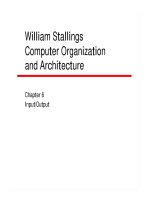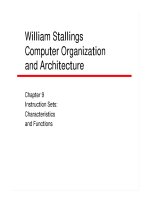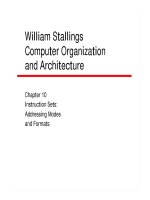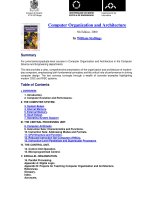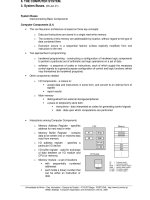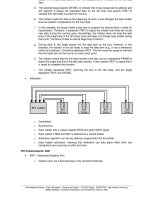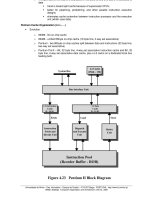William Stallings Computer Organization and Architecture P1
Bạn đang xem bản rút gọn của tài liệu. Xem và tải ngay bản đầy đủ của tài liệu tại đây (71.13 KB, 53 trang )
William Stallings
Computer Organization
and Architecture
Chapter 6
Input/Output
Input/Output Problems
§ Wide variety of peripherals
• Delivering different amounts of data
• At different speeds
• In different formats
§ All slower than CPU and RAM
§ Need I/O modules
Input/Output Module
§ Entity of the computer that controls external devices & exchanges
data between CPU, Memory and external devices
§ Interface to CPU and Memory
§ Interface to one or more peripherals
§ GENERIC MODEL OF I/O DIAGRAM 6.1
External Devices
§ Human readable
• Screen, printer, keyboard
§ Machine readable
• Monitoring and control
§ Communication
• Modem
• Network Interface Card (NIC)
I/O Module Function
§ Control & Timing
• Coordinate the flow of traffic between CPU & mem & external
devices
§ CPU Communication
• Commands decoding, Status reporting, I/O device address
recognition
§ Device Communication
• Send commands, receive status info. Data transfer
§ Data Buffering : difference in transfer rate of CPU, M, P
§ Error Detection
• Mulfunction of devices, transmission error
I/O Steps
§ CPU checks I/O module device status
§ I/O module returns status
§ If ready, CPU requests data transfer
§ I/O module gets data from device
§ I/O module transfers data to CPU
§ Variations for output, DMA, etc.
I/O Module Diagram
Data Register
Status/Control Register
External
Device
Interface
Logic
External
Device
Interface
Logic
Input
Output
Logic
Data
Lines
Address
Lines
Data
Lines
Data
Status
Control
Data
Status
Control
Systems Bus Interface
External Device Interface
I/O Module Decisions
§ Hide or reveal device properties to CPU
§ Support multiple or single device
§ Control device functions or leave for CPU
§ Also O/S decisions
• e.g. Unix treats everything it can as a file
Input Output Techniques
§ Programmed
§ Interrupt driven
§ Direct Memory Access (DMA)
Programmed I/O
§ CPU has direct control over I/O
• Sensing status
• Read/write commands
• Transferring data
§ CPU waits for I/O module to complete operation
§ Wastes CPU time
Programmed I/O - detail
§ CPU requests I/O operation
§ I/O module performs operation
§ I/O module sets status bits
§ CPU checks status bits periodically
§ I/O module does not inform CPU directly
§ I/O module does not interrupt CPU
§ CPU may wait or come back later
§ When ready, CPU reads word from I/O module
§ Writes to memory
I/O Commands
§ CPU issues address
• Identifies module (& device if >1 per module)
§ CPU issues command
• Control - telling module what to do
üe.g. spin up disk
• Test - check status
üe.g. power? Error?
• Read/Write
üModule transfers data via buffer from/to device
§ I/O command : issued by CPU to I/O module
§ I/O instruction : fetched from & executed by CPU
§ In programmed I/O, usually one instruction = one I/O command
Addressing I/O Devices
§ Under programmed I/O data transfer is very like memory access (CPU
viewpoint)
§ Each device given unique identifier
§ CPU commands contain identifier (address)
I/O Mapping
§ Memory mapped I/O
• Devices and memory share an address space
• I/O looks just like memory read/write
• No special commands for I/O (No I/O instruction)
ü Large selection of memory access commands available
§ Isolated I/O
• Separate address spaces
• Need I/O or memory select lines
• Special commands for I/O
üLimited set
Interrupt Driven I/O
§ Overcomes CPU waiting
§ No repeated CPU checking of device
§ I/O module interrupts when ready
§ But, CPU still control transfer
Interrupt Driven I/O
Basic Operation
§ CPU issues read command
§ I/O module gets data from peripheral whilst CPU does other work
§ I/O module interrupts CPU
§ CPU requests data
§ I/O module transfers data
CPU Viewpoint
§ Issue read command
§ Do other work
§ Check for interrupt at end of each instruction cycle
§ If interrupted:-
• Save context (registers)
• Process interrupt
üFetch data & store
§ See Operating Systems notes
Design Issues
§ How do you identify the module issuing the interrupt?
§ How do you deal with multiple interrupts?
• i.e. an interrupt handler being interrupted
Identifying Interrupting Module
(1)
§ Different line for each module
• PC
• Limits number of devices
§ Software poll
• CPU asks each module in turn
• Slow
• Priority is established by the order in which module are polled
Identifying Interrupting Module
(2)
§ Daisy Chain or Hardware poll
• Interrupt Acknowledge sent down a chain
• Module responsible places vector on bus
• CPU uses vector to identify handler routine
§ Bus Master
• Module must claim the bus before it can raise interrupt
• e.g. PCI & SCSI
Multiple Interrupts
§ Each interrupt line has a priority
§ Higher priority lines can interrupt lower priority lines
§ If bus mastering only current master can interrupt
Example - PC Bus
§ 80x86 has one interrupt line
§ 8086 based systems use one 8259A interrupt controller
§ 8259A has 8 interrupt lines
Sequence of Events
§ 8259A accepts interrupts
§ 8259A determines priority
§ 8259A signals 8086 (raises INTR line)
§ CPU Acknowledges
§ 8259A puts correct vector on data bus
§ CPU processes interrupt
PC Interrupt Layout
8086
INTR
8259A
IRQ0
IRQ1
IRQ2
IRQ3
IRQ4
IRQ5
IRQ6
IRQ7
ISA Bus Interrupt System
§ ISA bus chains two 8259As together
§ Link is via interrupt 2
§ Gives 15 lines
• 16 lines less one for link
§ IRQ 9 is used to re-route anything trying to use IRQ 2
• Backwards compatibility
§ Incorporated in chip set
